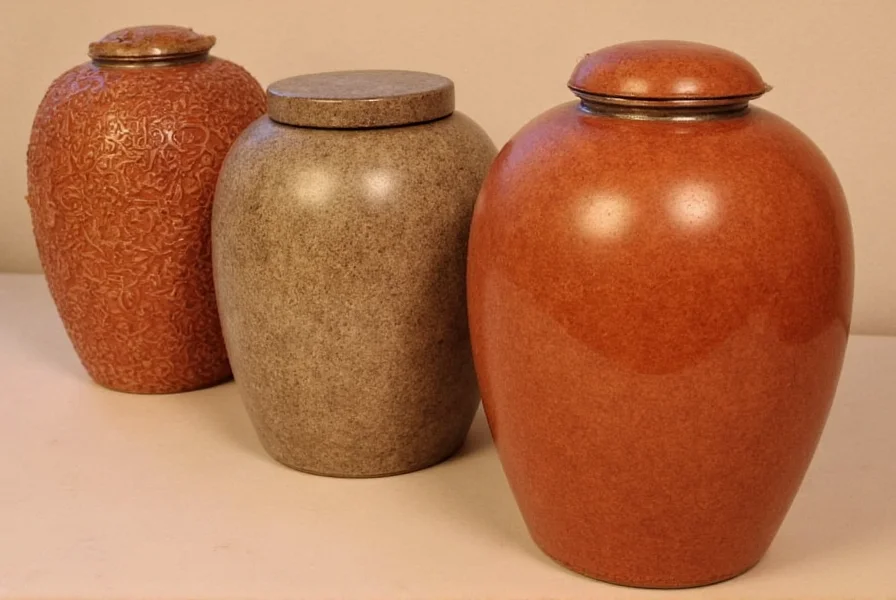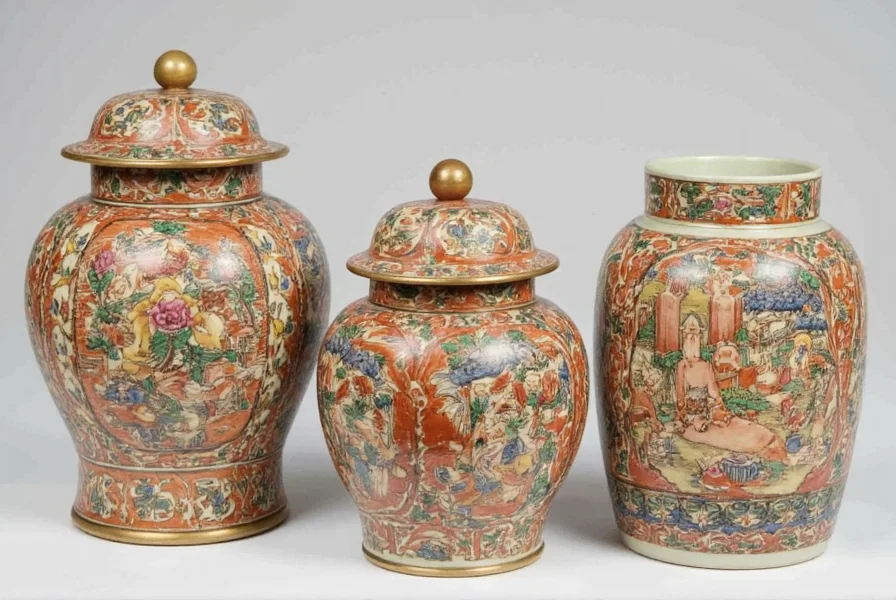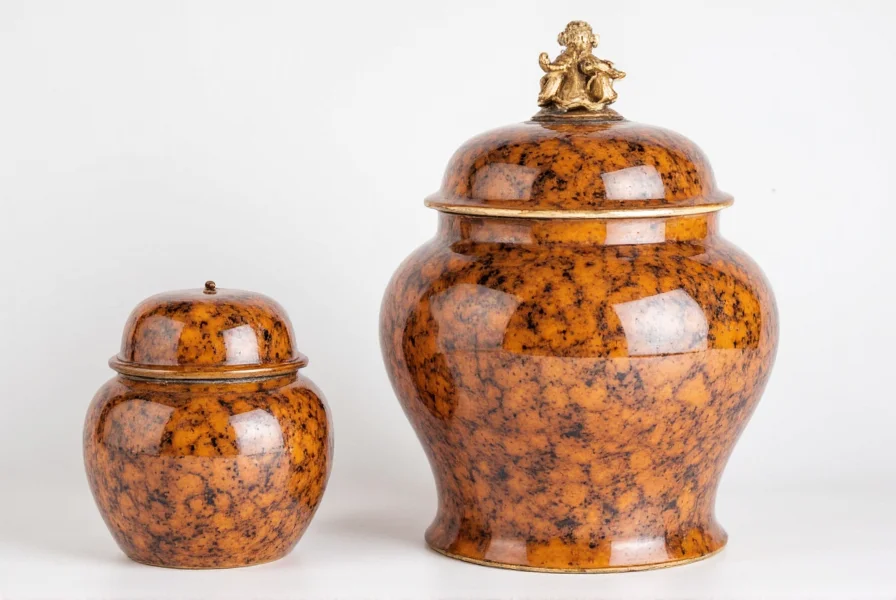Ginger jars represent one of the most enduring decorative objects in interior design history, bridging centuries of craftsmanship with contemporary aesthetic appeal. These distinctive ceramic vessels, characterized by their cylindrical shape, narrow neck, and signature domed lid, originated in China during the 14th century Ming Dynasty. Initially created as functional storage containers for precious spices like ginger, tea, and herbs, they gradually transformed into status symbols among Chinese aristocracy before capturing Western attention through global trade routes.
Historical Evolution of Ginger Jars
The earliest ginger jars emerged during China's Ming Dynasty (1368-1644), crafted primarily from porcelain with cobalt blue underglaze decorations depicting traditional motifs like dragons, phoenixes, and floral patterns. These functional containers gained international prominence during the 17th and 18th centuries when European traders, particularly the Dutch East India Company, began importing them in large quantities. Western consumers quickly appreciated both their practical storage capabilities and striking visual appeal, leading to widespread incorporation into European homes.
By the 19th century, ginger jars had evolved from purely functional objects to coveted decorative pieces. The Victorian era saw them prominently displayed in parlors and dining rooms across Europe and America, often arranged in groupings on mantelpieces or sideboards. This decorative tradition continues today, with both antique collectors and interior designers recognizing their timeless aesthetic value.
Authentic Antique vs. Modern Reproductions
Distinguishing between authentic antique ginger jars and contemporary reproductions requires attention to several key characteristics. Genuine antique pieces typically show subtle imperfections in the porcelain body, hand-painted designs with slight variations, and evidence of age-appropriate wear. The cobalt blue decoration on authentic Ming and Qing dynasty jars often displays a slight grayish undertone rather than the vibrant blue of modern reproductions.
| Feature | Authentic Antique | Modern Reproduction |
|---|---|---|
| Porcelain Quality | Slightly irregular thickness, natural variations | Uniform thickness, machine-perfect |
| Painting Style | Hand-painted with subtle brush variations | Often machine-printed or too precise |
| Base Markings | Imperial reign marks or artisan signatures | "Made in China" or no markings |
| Color Palette | Subtle variations in blue, possible gray tones | Bright, uniform colors |
Collectors seeking vintage Chinese ginger jars history should research specific dynastic periods, as Ming dynasty pieces (1368-1644) typically feature simpler designs compared to the more elaborate Qing dynasty (1644-1912) examples. The most valuable antique ginger jars often originate from the Kangxi period (1662-1722), known for exceptional craftsmanship and distinctive blue-and-white decoration.
Contemporary Decorative Applications
Modern interior designers have embraced ginger jars as versatile decorative elements that work across multiple design aesthetics. The classic blue-and-white variety complements coastal, traditional, and transitional decor schemes, while contemporary interpretations in solid colors or metallic finishes enhance modern and eclectic spaces.
When considering how to style ginger jars in home decor, professionals recommend several effective approaches:
- Grouping multiple jars of varying heights on a bookshelf or console table creates visual interest through rhythm and repetition
- Using a single large ginger jar as a dramatic focal point in an entryway or living room
- Pairing ginger jars with complementary textures like linen, rattan, or wood for balanced compositions
- Incorporating them into tablescapes as unique centerpieces for dining or coffee tables
- Displaying them in pairs flanking a fireplace or doorway to create symmetry
For those exploring blue and white ginger jar decorating ideas, consider these professional tips: place jars against neutral backgrounds to let their patterns shine, use them to add height variation in shelf displays, or incorporate them into monochromatic color schemes for sophisticated contrast. The timeless appeal of these vessels makes them particularly effective in creating what designers call "collected over time" aesthetics that feel curated rather than staged.

Material Considerations and Craftsmanship
Traditional ginger jars were crafted from porcelain, a material prized for its durability and ability to hold intricate designs. Authentic antique pieces feature hand-thrown bodies and hand-painted decorations, resulting in subtle variations that distinguish them from mass-produced items. Contemporary reproductions may use porcelain, stoneware, or even resin materials, with quality varying significantly based on manufacturing techniques.
When evaluating authentic vs reproduction ginger jars, examine the weight distribution (antiques often feel heavier at the base), check for hand-painted brushstrokes under magnification, and assess the overall balance of the piece. High-quality reproductions from reputable manufacturers can offer excellent decorative value at more accessible price points, making them practical choices for interior design applications where investment in genuine antiques isn't feasible.
Preservation and Care Guidelines
Proper care extends the life of both antique and contemporary ginger jars. Display pieces away from direct sunlight to prevent color fading, especially for antique pieces with more delicate pigments. Clean with a soft, dry cloth rather than liquid cleaners, which can damage porous surfaces or weaken antique glazes over time. For valuable antique collections, maintain stable environmental conditions with consistent temperature and humidity levels to prevent cracking or other damage.
When handling large ginger jars for interior design installations, always lift from the base rather than the neck to avoid stress on the most fragile part of the vessel. Consider using museum putty or specialized display stands to secure valuable pieces, particularly in homes with children or pets. These precautions ensure your ginger jar collection remains both beautiful and intact for years to come.

Common Misconceptions Addressed
Several misconceptions surround ginger jars that deserve clarification. Despite their name, these vessels weren't exclusively used for ginger storage—Chinese merchants utilized them for various precious commodities. The association with ginger specifically developed in Western markets where the jars often arrived containing this valuable spice.
Another common misunderstanding involves ginger jar collection value factors. While age contributes to value, condition, rarity of design, and provenance often matter more than mere antiquity. A well-preserved Qing dynasty jar with exceptional artwork may command higher prices than a damaged Ming piece. Additionally, contemporary artisan-made ginger jars from skilled ceramicists can hold significant value in their own right, separate from antique collectibility.
Integrating Ginger Jars Across Design Styles
The versatility of ginger jars makes them suitable for diverse interior design approaches. In traditional settings, they complement other Asian-inspired elements and classic European furnishings. Modern interiors benefit from their organic shapes and handcrafted quality, which provide welcome contrast to clean-lined contemporary furniture.
Coastal and beach-inspired spaces particularly benefit from blue-and-white ginger jars, which echo nautical color schemes while adding cultural depth beyond typical seaside decor. Even minimalist interiors can incorporate a single statement ginger jar as a carefully curated focal point that adds warmth and history without overwhelming the space.
Conclusion: Enduring Appeal of Ginger Jars
Ginger jars have maintained their decorative relevance through centuries of changing design trends by embodying the perfect balance of functionality and artistry. Their journey from practical Chinese storage containers to globally recognized decorative icons demonstrates how objects of utility can evolve into meaningful aesthetic elements. Whether incorporating antique treasures or contemporary interpretations, these vessels continue to offer interior designers and homeowners a versatile tool for creating spaces with depth, history, and visual interest.
What is the historical origin of ginger jars?
Ginger jars originated during China's Ming Dynasty (1368-1644) as functional porcelain containers for storing spices, tea, and other valuable commodities. They gained international prominence through European trade routes in the 17th and 18th centuries, evolving from practical storage vessels to decorative status symbols in Western homes by the Victorian era.
How can I tell if a ginger jar is an authentic antique?
Authentic antique ginger jars typically show subtle imperfections in the porcelain, hand-painted designs with brush variations, and age-appropriate wear. Ming dynasty pieces often have simpler designs with possible grayish undertones in the blue decoration, while Qing dynasty examples feature more elaborate artwork. Check for imperial reign marks on the base rather than modern "Made in China" labels.
What are the best ways to incorporate ginger jars into home decor?
Professional designers recommend grouping multiple jars of varying heights on shelves for visual rhythm, using a single large jar as a focal point, pairing them with complementary textures like wood or linen, or incorporating them into tablescapes as unique centerpieces. Blue-and-white varieties work particularly well against neutral backgrounds to highlight their intricate patterns.
Do ginger jars have to be blue and white?
While blue-and-white is the most traditional and recognizable color scheme for ginger jars, authentic antique examples exist in famille rose (pink famille), famille verte (green famille), and other polychrome decorations. Contemporary reproductions come in virtually any color, including solid hues, metallic finishes, and modern pattern interpretations, making them adaptable to various decor styles.
How should I care for valuable ginger jars?
Display ginger jars away from direct sunlight to prevent fading, clean with a soft dry cloth rather than liquid cleaners, and maintain stable temperature and humidity levels. When handling, always lift from the base rather than the neck. For valuable antique pieces, consider using museum putty or specialized display stands to secure them safely, especially in homes with children or pets.











 浙公网安备
33010002000092号
浙公网安备
33010002000092号 浙B2-20120091-4
浙B2-20120091-4